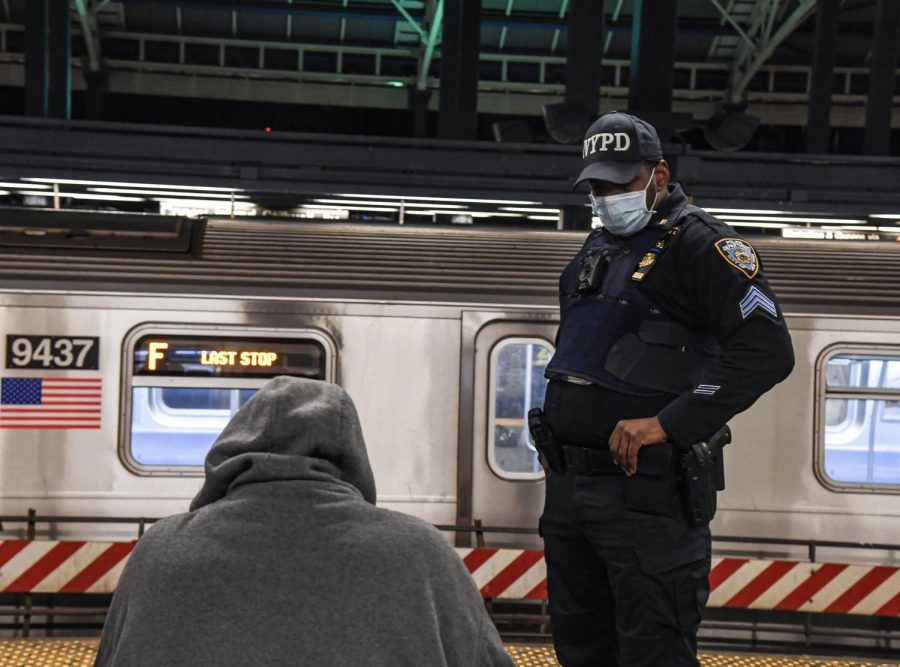Plans to help the homeless will soon prove ineffective
March 18, 2022
New York City Mayor Eric Adams and New York Gov. Kathy Hochul unveiled a new plan to tackle rising crime rates in New York City. Some are calling it the most aggressive effort to mitigate crime and homelessness within the transit system in decades.
However, the Subway Safety Plan will soon prove to be overambitious, with its promises to use police force to relocate the homeless, but no adequate housing to relocate them to.
Police will be asked to ramp up enforcement against spitting, laying down and littering in the subway, according to Adams. Additionally, homeless people riding the subway will be forcibly removed once they reach the end of the line.
The city maintains that while violence and homelessness on train station platforms are concurrent challenges, they should not be equated or conflated. The goal is to decrease the number of homeless individuals experiencing behavioral health issues by implementing immediate interventions to prevent the endangerment of commuters.
“No more smoking, no more doing drugs, no more sleeping, no more doing barbecues on the subway system,” Adams said during a press conference at the Fulton Street subway. “No more just doing whatever you want. No, those days are over … The system was not made to be housing, it’s made to be transportation.”
The new plan calls for the formation of “End of the Line” teams whose patrols will begin on the A, E, N, R, 1 and 2 lines. About 1,000 police officers have already been added to patrol throughout the system every day, according to NYPD commissioner Keechant Sewell.
It also entails the addition of nearly 490 safe haven and “stabilization beds,” shelters that provide mental health services, in conjunction with an increase in new drop-in centers at key subway stations. These humanitarian efforts will be funded through a $100 million state investment.
The city also plans to dispatch 30 joint response teams, including health department workers and homeless services that will conduct outreach to homeless individuals living in the transit system.
This new campaign appears to be a reversal of the homeless intervention protocol put in place by former New York City Mayor Bill de Blasio in 2020, which called for a reduction in the presence of law enforcement during the peak of social justice protests that year.
More recently, a drastic increase in commuters following the end of the pandemic has been met with an equally drastic rise in crime, up nearly 67% this year.
Additionally, several high-profile violent transgressions have put New Yorkers on edge. On Jan. 15, Michelle Go was fatally shoved onto the subway tracks by Martial Simon, a homeless individual who had spent years bouncing between psychiatric wards and homeless shelters before the attack, according to The New York Times.
On Feb. 21,Frank Abworka, a homeless man with a lengthy arrest record, smeared a stranger with human feces as she waited for a train in the Bronx.
These occurrences spurred New Yorkers to demand a plan of action from the mayor and the governor. To soothe the public’s anxiety, the Subway Safety Plan might have been scraped together too hastily to work.
“We are terrified about what is to come,” Josh Dean, Executive Director of Human.NYC., said. “Aggressive NYPD targeting of homeless New Yorkers does not solve homelessness — it just moves it. We need to take an entirely different approach, centered around housing, around compassion, and around building trust. We cannot more strongly condemn today’s plan and the dehumanizing rhetoric that accompanied it.”
Many fear that the plan’s housing aspect might take years and substantial funding to implement, while the degree of police enforcement could become excessive overnight.
Additionally, advocates are expressing concerns surrounding the plan’s use of Kendra’s Law, a state statute passed in 1999 which allows courts to force individuals into psychiatric treatment.
In the past, the invocation of Kendra’s law has always resulted in an uptick in senseless arrests and racial profiling. A 2005 analysis by the New York lawyers for the Public Interest report revealed that Black people were five times as likely as white people to be court-ordered into treatment.
Similarly, nearly 85% of individuals who were given court orders did not have a history of violence, but rather, a history of psychiatric hospitalizations. Another spin around the same merry-go-round would be an ineffective means of treatment, serving to waste public tax dollars without necessarily benefiting the homeless.
Thus, the Subway Safety Plan will almost certainly prove to be a Band-Aid on a bullet-hole approach to subway reform, a mere stopgap until leadership finally addresses the issues at the root of the homelessness crisis.
In the interim, Adams could dedicate more funding toward the “Right to Counsel,” which de Blasio signed into law in 2017. This bill, which gave the right to counsel in housing court for low-income tenants facing eviction, caused the city shelter population to decline, marking one of the very few successes of the de Blasio administration.
Above all, the Adams’ administration must work toward an effective, long-term solution to providing subsidized housing to target the city’s poorest. Until then, subway crime will likely level or continue to rise.








